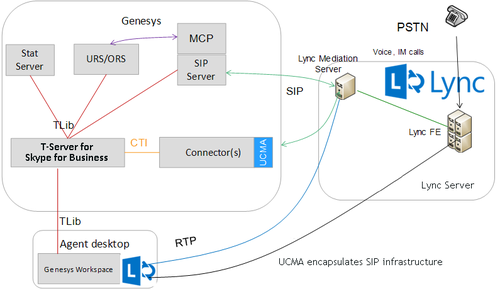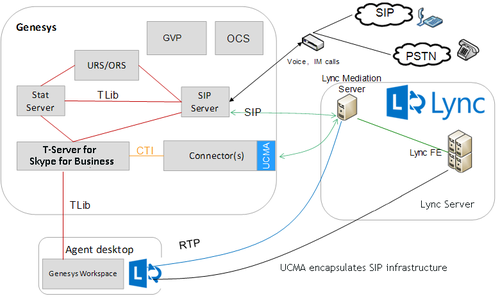Architecture
Contents
T-Server for Skype for Business has the same position in the Genesys Media Layer as all Genesys T-Servers. T-Server provides an interface between the Microsoft telephony implementation and the rest of the Genesys software components in your enterprise. It translates and keeps track of events and requests that come from, and are sent to, the Microsoft Skype for Business Server and its phone applications. T-Server is a TCP/IP-based server that can also act as a messaging interface between T-Server clients.
In addition to voice communications, T-Server for Skype for Business manages other media provided by the Microsoft platform, namely: presence, IM sessions, and video calls. It is therefore more expansive than other T-Servers and provides some specialized functions that are unique to the Skype for Business integration service.
T-Server consists of two components:
- T-Server—Provides the standard interface to other Genesys applications and third-party T-Server clients. It has access to the Genesys Management Framework and the Genesys configuration database. T-Server utilizes full capabilities of the Framework for logging, alarming, and secure communications.
- Connector—Provides the communication with Microsoft facilities. It does not have connection to the Genesys Framework.
The Genesys Workspace Desktop Edition Plugin for Skype for Business should be installed on the desktop of agents who interact with the system, to fully exploit the T-Server features and to provide a good agent experience..
T-Server in Front
In the T-Server in Front architecture, calls first get to Skype for Business as shown in the following figure, and are then routed to T-Server.
T-Server supports treatments through SIP Server using GVP's Resource Manager and Media Control Platform. All treatment types are inherited from SIP Server, so most of the SIP Server strategies can be re-used. Note that the No-Answer Supervision feature is implemented differently comparing to SIP Server, because of call-model differences. For more information, see the No-Answer Supervision feature.
SIP Server In Front
In the configuration shown in the figure below (the standard deployment), T-Server is deployed behind a SIP Server. Calls land on SIP Server and all inbound calls (from customers to agents) are routed by SIP Server to a Microsoft Skype for Business Routing Point. Customer endpoints communicate directly with SIP Server. This architecture allows using outbound elements.
Multi-Site Support
T-Server is built with the T-Server Common Part that contains the ISCC component responsible for call data transfer between multiple sites. Currently, T-Server supports the following ISCC transaction types:
- route as origination and destination
- pullback as origination and destination
T-Server for Skype for Business supports ISCC connections with SIP Server and other T-Servers, but does not support ISCC connections with other instances of T-Server for Skype for Business.
For information about supported ISCC transaction types and ISCC features, see Multi-Site Support.
SBA/SBS Support
Starting with version 8.5.001.49, T-Server for Skype for Business supports user endpoints registered on a Survivable Branch Appliance (SBA) or a Survivable Branch Server (SBS) front-end server. When the SBA or SBS is disconnected from the main Skype for Business server, T-Server cannot control calls on such users until connection is restored.



